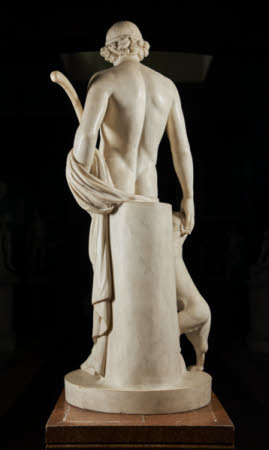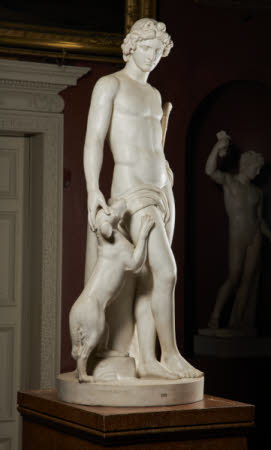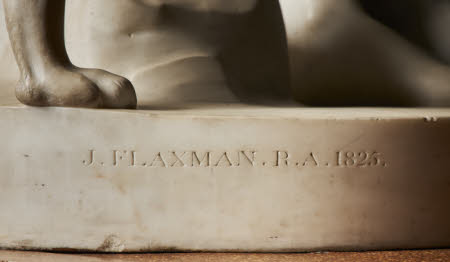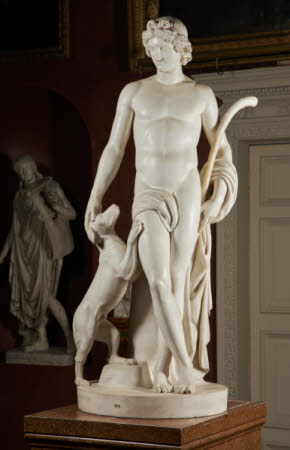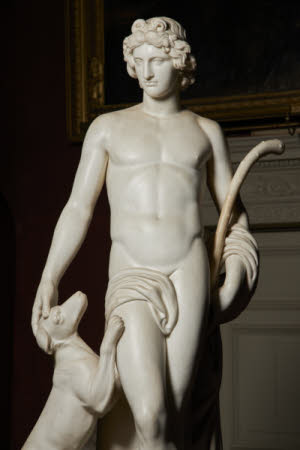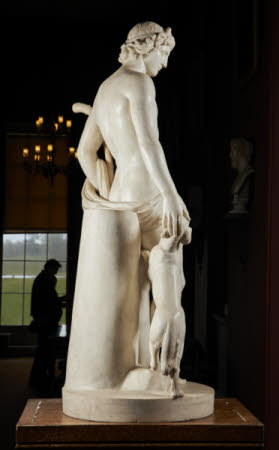Pastoral Apollo
John Flaxman (York 1755 - London 1826)
Category
Art / Sculpture
Date
1813 - 1825 (signed and dated)
Materials
Marble
Measurements
1815 mm (Height); 1080 mm (Height); 698 mm (Diameter)
Place of origin
England
Order this imageCollection
Petworth House and Park, West Sussex
NT 486405
Caption
Pastoral Apollo was commissioned in 1813 from Flaxman by the George O’Brien Wyndham, 3rd Earl of Egremont (1751-1837) and is signed and dated 1825. The marble sculpture, which cost 900 guineas and took 12 years to complete, depicts Apollo as the protector of shepherds. He stands, partially clothed, with his hand on the head of a dog standing on its back legs. Apollo was one of the Twelve Olympian Greek gods, a symbol of light, of youthful manly beauty and of reason. He is also associated with music, archery, medicine, the care of flocks and herds and with prophecy.
Summary
Marble sculpture, Pastoral Apollo by John Flaxman RA (York 1755 – London 1826), commissioned in 1813 and completed and signed and dated in 1825. It was Lord Egremont's first commission of an ideal subject, and depicts Apollo as the protector of shepherds. Apollo partially clothed stands with his hand on the head of a dog standing on its back legs. Apollo was one of the 'Twelve Olympian' Greek gods, a symbol of light, of youthful manly beauty and of reason. He is also associated with music, archery, medicine, the care of flocks and herds and with prophecy. The island of Delos was sacred to him from earliest times, as it was there that Leto gave birth to him and his sister Artemis. Of the many statues of him in antiquity the most famous originals are perhaps the one dating from the mid fifth century from the west pediment of the temple at Olympia, and the Etruscan 'Apollo of Veii' of 510 BC. The sculptor's unpublished second account book (Columbia University, New York) reveals that Lord Egremont's first payment was made in 1813, so the sculpture took Flaxman twelve years to complete at a cost of 900 guineas.
Provenance
Commissioned by the 3rd Earl of Egremont in 1813 and completed in 1825 and thence by descent, until the death in 1952 of the 3rd Lord Leconfield, who had given Petworth to the National Trust in 1947, and whose nephew and heir, John Wyndham, 6th Lord Leconfield and 1st Lord Egremont (1920-72) arranged for the acceptance of the major portion of the collections at Petworth in lieu of death duties (the first ever such arrangement) in 1956 by H.M.Treasury.
Credit line
Petworth, The Egremont Collection (National Trust)
Marks and inscriptions
101 (painted on front of base)
Makers and roles
John Flaxman (York 1755 - London 1826), sculptor
